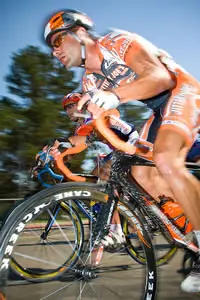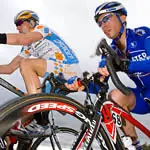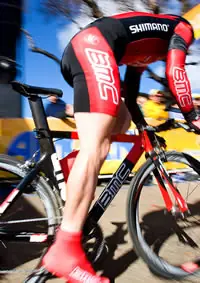Capturing the perfect picture of a moving cyclist is tough, but not impossible. Whether you want to take a photo of the world's best pro riders in the Tour of California or snap a shot of your friend during a group ride, use these five tips to use your camera like a professional—with all the color and drama intact.

1. Use your flash. Ever wonder why the pro photographers on motorcycles in the Tour de France use a flash under a blazing sun? The midday sun casts dark shadows on the faces and bodies of riders. Using a strobe fills those shadows with light and creates richer, more dynamic images. Follow the pros' lead and turn your flash on—even when intuition and the bright sun tell you it's the last thing you need. If you're using a point-and-shoot camera, you may need to switch out of the auto mode and into fill-flash mode.
2. Choose the right shutter speed. To stop action, choose a shutter speed that is 1/250 of a second or faster. Many point and shoot and digital SLR cameras have an automatic sports setting that takes care of this for you. However, don't be afraid to use a slower shutter speed along with judicious panning.
More: 16 Cool Cycling Tattoos
As the cyclists go past, move your camera along with the riders and shoot. This combination of slow shutter speed and panning keeps the cyclist in focus while blurring the background. It's a terrific effect that, when done right, yells out the speed, excitement and drama of bike racing. A shutter speed of 1/100 or 1/125 of a second is often just right. For even more dramatic effect, drop your shutter speed even lower—to 1/30 or 1/15 of a second—and pan while using a fill flash.

3. Pay attention to backgrounds. Pro photographers pay as much attention to what's behind their subject as to the subject itself. When choosing a location to shoot passing cyclists, mind what's across the road. The colorful peloton will really pop when shot against a dark, uniform background. Canopies of dark green trees are ideal, as are cliffs or open skies. Avoid distracting elements like light poles, ugly buildings, parked trucks or street signs. Anything that competes with the main subject—the cyclists—is something you want to keep out of your photo.
More: Rules and Etiquette for Group Rides

4. Shoot high and shoot low. Great photographs startle us with a fresh way of looking at the world. To create arresting cycling photos, try shooting up from a low-to-the-ground angle or down from up in the air. These mouse and bird's-eye views work because humans are accustomed to seeing cyclists pass by from the point of view of our eyes—about five feet off the ground. By shooting from low and high angles, you create images that short-circuit the human expectations formed by a lifetime of seeing cyclists from eye level.
5. Practice. Before today's auto-focus lenses and digital imaging, becoming a good cycling photographer was a frustrating and costly enterprise (15 bucks to buy and process 36 slides adds up quick!). Today, it costs the same to shoot 1,000 images as 36. So take lots of cycling photos! Like any craft, photography rewards those who practice with better and better results. Find a local triathlon or bike race and spend the day experimenting with shutter speeds, flashes, angles and backgrounds. Once you get the images on your computer, you'll see what works and what doesn't.
More: 10 Things I Learned From Being Hit by a Car
 Ready to ride? Search for a cycling event.
Ready to ride? Search for a cycling event.


